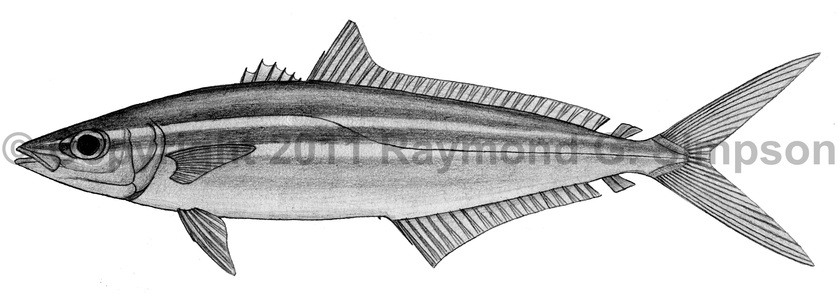
Common Name
Rainbow Runner
Year Described
Quoy & Gaimard, 1825
Identification
Dorsal Fin: 6 spines in first lobe, followed by I, 25-30 (last two rays detached as finlets)
Anal Fin: 1 spine separate from rest (embedded in some fish), followed by I, 18-22 (last two rays detached as finlets)
Pelvic Fin: I, 5
Gill Rakers: 6-7 upper, 15-20 lower; 21-27 total
Vertebrae: 10 precaudal, 15 caudal
Highly elongate with a large head, pointed snout, and small eye. Jaw small; does not reach anterior margin of eye. Bands of small villiform teeth in jaws and also minute teeth on tongue and roof of mouth. Pectoral fins two times shorter than head. Anterior lobe of soft dorsal fin slightly raised. Anterior lobe of anal fin also slightly raised, and anal fin base is shorter than the dorsal base. Tail deeply forked. Lateral line with curved anterior portion and straight posterior portion with no scutes. Very small ctenoid scales on entire body (including chest, paired fins, and caudal fin). Dorsal/ventral grooves present on cuadal peduncle. No lateral caudal keels.
Color
Dorsal surface olive-green to blue-green, and whitish below. Two lateral blue stripes on side from snout to caudal peduncle with a green to yellow stripe in between (middle stripe dark on snout). Fins dusky-green to yellowish.
Size
Common to 80cm FL. Maximum size to >110cm FL.
Habitat
Inshore and offshore pelagic, but also over reefs. Often forms large schools.
Range
Massachusetts to NE Brazil, including Bermuda and the Caribbean islands.
References
Smith-Vaniz, W.F. 2003. Carangidae (pp 1426-1468). In: Carpenter. 2003. The living marine resources of the Western Central Atlantic v. 3.